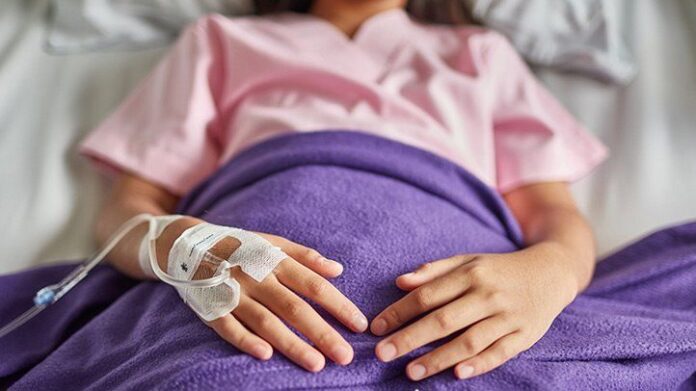The most useful individual signs for identifying dehydration in children are prolonged capillary refill time, abnormal skin turgor, and abnormal respiratory pattern. However, clinical dehydration scales based on a combination of physical examination findings are better predictors than individual signs. Oral rehydration therapy is the preferred treatment of mild to moderate dehydration caused by diarrhea in children. Goals of oral rehydration therapy are restoration of circulating blood volume, restoration of interstitial fluid volume, and maintenance of rehydration. When rehydration is achieved, a normal age-appropriate diet should be initiated.
Clinical dehydration scales based on a combination of physical examination findings are the most specific and sensitive tools for accurately diagnosing dehydration in children and categorizing its severity. Overdiagnosis of dehydration may lead to unnecessary tests and treatment, whereas underdiagnosis may lead to increased morbidity (e.g., protracted vomiting, electrolyte disturbances, acute renal insufficiency).
PARENTAL OBSERVATION
Parental report of vomiting, diarrhea, or decreased oral intake is sensitive, but not specific, for identifying dehydration in children. If parents report that the child does not have diarrhea, has normal oral intake, and has normal urine output, the chance of dehydration is low. Likewise, when parents are asked about physical signs of dehydration, a number of positive answers suggest dehydration. However, if the parents report normal tear production, the chance of dehydration is low.
PHYSICAL EXAMINATION
Comparing change in body weight from before and after rehydration is the standard method for diagnosing dehydration.4 To identify dehydration in infants and children before treatment, a number of symptoms and clinical signs have been evaluated and compared with this standard method. Physical examination findings during dehydration represent desiccation of tissue, the body’s compensatory reaction to maintain perfusion, or both. The most useful individual signs for identifying dehydration are prolonged capillary refill time, abnormal skin turgor, and abnormal respiratory pattern.5 However, clinical dehydration scales based on a combination of physical examination findings are much better predictors than individual signs.
LABORATORY ASSESSMENT
Unlike in adults, calculation of the blood urea nitrogen (BUN)/creatinine ratio is not useful in children. Although the normal BUN level is the same for children and adults, the normal serum creatinine level changes with age (0.2 mg per dL [17.68 μmol per L] in infants to 0.8 mg per dL [70.72 μmol per L] in adolescents). BUN alone and urine specific gravity also have poor sensitivity and specificity for predicting dehydration in children.10
In combination with a clinical dehydration scale, a serum bicarbonate level of less than 17 mEq per L (17 mmol per L) may improve sensitivity of identifying children with moderate to severe hypovolemia.11 Additionally, a serum bicarbonate level of less than 13 mEq per L (13 mmol per L) is associated with increased risk of failure of outpatient rehydration efforts.
ORAL REHYDRATION THERAPY
The American Academy of Pediatrics recommends oral rehydration therapy (ORT) as the preferred treatment of fluid and electrolyte losses caused by diarrhea in children with mild to moderate dehydration.14 ORT is as effective as intravenous fluid in rehydration of children with mild to moderate dehydration—there is no difference in failure rate or hospital admission rate between the two treatments.15 Additionally, ORT has many advantages compared with intravenous fluid therapy. It can be administered at home, reducing the need for outpatient and emergency department visits; requires less emergency department staff time; and leads to shorter emergency department stays. Parents are also more satisfied with the visit when ORT had been used.16 With ORT, the same fluid can be used for rehydration, maintenance, and replacement of stool losses; and ORT can be initiated more quickly than intravenous fluid therapy.17
Hypernatremia, hyponatremia, and hypoglycemia occasionally complicate dehydration. Serum electrolyte levels should be measured in children with severe dehydration and in those with moderate dehydration that presents in atypical ways.
Analysis:
It is clear from this reading that parents do not always know when their child is dehydrated. They can tell the severe symptoms after the child is severely dehydrated and needs to take further measures. What if they were able to prevent it before it got that bad? This is exactly why a easily accessible monitoring device would be crucial when caring for a sick child. It’s great that there is so many resources for rehydration out there for parents. But what if it didn’t need to get to that point?
Source:
Canavan, A., & Billy S. Arant, J. (2009, October 1). Diagnosis and management of dehydration in children. American Family Physician. Retrieved September 5, 2022, from https://www.aafp.org/pubs/afp/issues/2009/1001/p692.html




